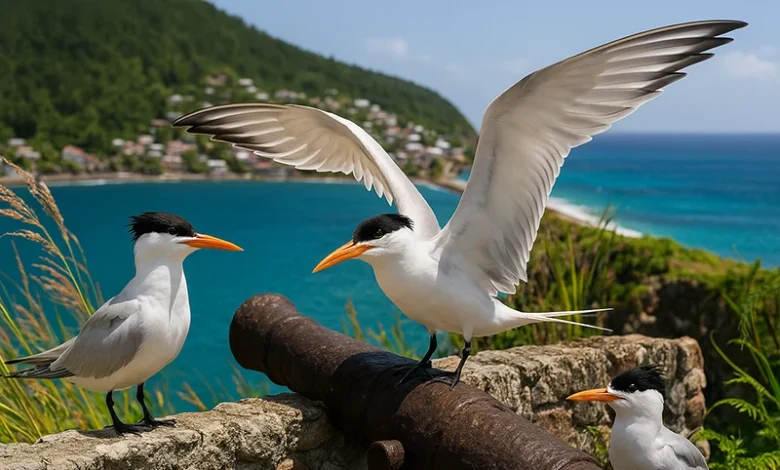Royal Tern

The Royal Tern (Thalasseus maximus) is a striking seabird commonly observed along Dominica’s coastlines. Notably, there is no widely recognised local name for this species in Dominica. However, in some Caribbean regions, it is referred to as “Meuchi real” in Papiamentu.
Appearance and Identification
The Royal Tern is a large tern, measuring approximately 45–50 cm (18–20 inches) in length with a wingspan of about 130 cm (51 inches). It has a slender body, long pointed wings, and a deeply forked tail. Adults display a pale gray back and white underparts. During the breeding season, they exhibit a black cap extending from the bill to the back of the head, which recedes to a black crest in non-breeding months. Their most distinctive feature is the bright orange-red bill.
Habitat and Distribution in Dominica of the Royal Tern
Royal Terns are typically found along coastal regions, favoring sandy beaches, estuaries, and lagoons. In Dominica, they are often seen in areas such as:
- Layou River Mouth: A known spot where these terns congregate.
- Prince Rupert Bay in Portsmouth: Regular sightings have been reported here.
- Soufrière Bay: Another area where they are commonly observed.
These birds are rarely found far inland, as they prefer coastal environments.
Behavior and Diet
Royal Terns primarily feed on small fish, which they catch by executing swift, shallow dives into the water. They are often observed flying over the ocean, scanning for prey, and then plunging to capture it. These terns are social birds, frequently seen in groups, especially during breeding and roosting periods.
Breeding and Nesting
While Royal Terns breed on coastal islands and sandbars, there is limited information about their breeding habits specific to Dominica. They typically nest in large, dense colonies, laying their eggs directly on sandy or shelly ground without constructing elaborate nests.
Conservation Status
The Royal Tern is currently listed as a species of “Least Concern” by the IUCN, indicating a stable global population. However, they are susceptible to threats such as habitat disturbance, pollution, and human activities that impact coastal environments. Protecting Dominica’s coastal habitats is vital to ensure the continued presence of these elegant seabirds.




